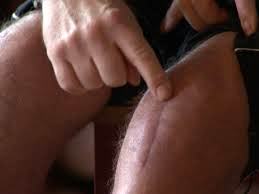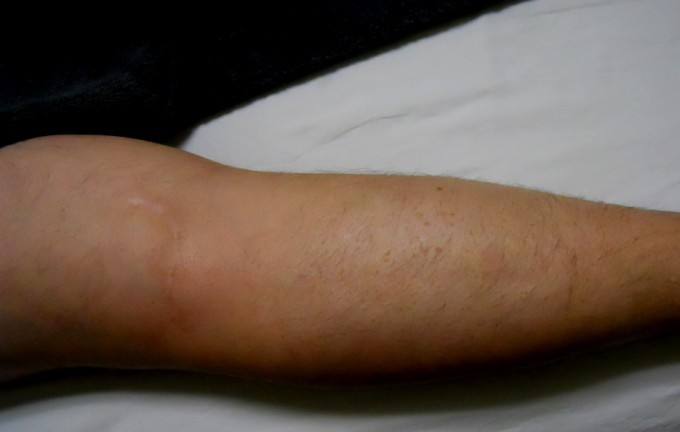Recently a 45 year old patient came to our clinic. A year ago he had a total left knee replacement. The pain in the knee affected by osteoarthritis was gone but the active ROM was restricted. PT was able to recover knee active flexion up to 90 degrees only.
Approximately a month ago he developed the clinical picture of left side Sciatic Nerve Neuralgia with acute pain, severe numbness and burning pain on the posterior leg and especially on the bottom of the foot. He also developed muscle weakness on the left to the degree that he was not able to support his weight while standing on the toes of his left foot. The evaluation pointed to the tibial division of the sciatic nerve as being mostly affected. An MRI indicated 5 mm herniation of L5 intervertebral disk with significant spinal stenosis.
For almost three weeks the patient was treated in our clinic with Medical Massage protocols for his Sciatic Nerve Neuralgia due to disk herniation. We were able to recover lost functions and eliminate pain and other uncomfortable sensations. What was left was moderate numbness on the bottom of the foot, which comes and goes. What was puzzling was that the patient felt numbness on the bottom of the foot while he was walking, but it didn’t bother him if he was standing even for a long time. If the sensory deficit (i.e. numbness) is due to the disk pathology, the patient more likely will have clinical symptoms more pronounced when he stands.
The repeated evaluation confirmed that the numbness didn’t come from the herniated disk and we felt we were reaching a dead end, with the possibility that this occasional numbness may stay with the patient for some time or even forever. However, there was something odd with all his symptoms.
Last week while working on his left lower back and gluteal area as a preventive measure, we decided to examine his leg one more time.
Usually after total knee replacement surgery, the patient has scars on the anterior knee surface. In Fig.1 the patient indicates the location of his postsurgical scar after left total knee replacement.

Fig. 1. Scar on the anterior left knee surface after knee replacement surgery
What was unusual in our patient is that he also had an S-like scar on the posterior surface of the left knee in the popliteal fossa (see Fig. 2).

Fig. 2. Post-surgical scar in the popliteal fossa of our patient
While being on his stomach, the patient didn’t have any numbness on the bottom of the left foot. We decided to examine the scar itself and as soon as we applied moderate pressure just below the scar at the entrance of the tibial nerve into the soleus canal, the patient immediately reported numbness on the bottom of the left foot. The application of pressure along the soleus canal also triggered numbness on the bottom of the foot. The video below illustrates the application of pressure along the soleus canal where the tibial nerve is located.
The application of three sessions of MEDICAL MASSAGE PROTOCOL for Tibial Nerve Neuralgia due to nerve compression in the soleus canal completely eliminated occasional numbness on the bottom of the foot.
LESSONS:
1. Post-surgical scars seen on the skin also affect the function of the soft tissue structures located in the deeper layers and may contribute to the development of clinical symptoms.
2. In our patient the scar in the popliteal fossa decreased elasticity of the soft tissues at the entrance into the soleus canal. Acute Sciatic Nerve Neuralgia as a result of disk herniation additionally increased pressure within the canal since it triggered a reflex spasm in the gastrocnemius and soleus muscles. As a result of these events the tibial nerve became slightly irritated within the soleus canal and it triggered numbness in the areas where the nerve ends (i.e. bottom of the foot), especially when the patient walks for some distance since the long walk increase friction of the nerve between two powerful muscles.
Dr. Ross Turchaninov, Phoenix
Category: Blog , News
